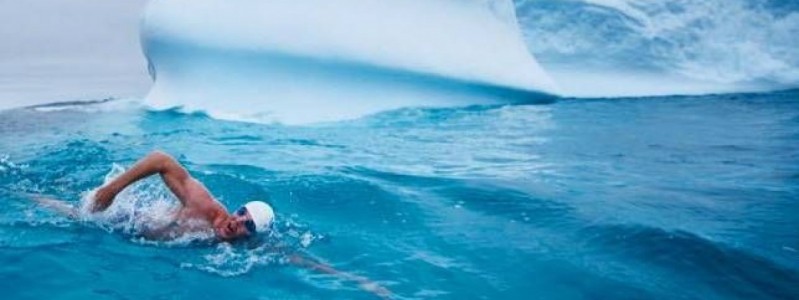Podcast episode 03 - Published 13 July, 2017 by Nicholas O'Flaherty
Tweet
This week, in our podcast, we speak to Lewis Pugh, one of the heroes of the successful campaign that led to the establishment of a Marine Protected Area in the Ross Sea. It becomes effective from 1 December, 2017.
Fisheries in the Southern Ocean are governed by an international body within the Antarctic Treaty System, the Commission on the Conservation of Antarctic Marine Living Resources (or CCAMLR).
In 2002, scientists began to lobby CCAMLR for protected status for the Ross Sea. After many years of lobbying, in 2016 all member states of CCAMLR voted to create an MPA, or Marine Protected Area, for the Ross Sea.
Born in Britain, raised in South Africa, Lewis Pugh became a successful long distance swimmer, notching up memorable swims such as the English Channel, Robben Island and Lake Malawi.
It was in 2006 however, with a swim down the River Thames, that Lewis began to use his swims to raise public awareness about the dangers of global warming. Soon, swims in the Maldives and across the North Pole followed. Lewis Pugh became an advocate for the protection of the oceans; the media dubbed it speedo diplomacy.
In 2013 he became United Nations Patron of the Oceans, and his attention turned to Antarctica. In 2015 Lewis made a number of swims in icy Antarctic waters including the Ross Sea itself, gaining significant media attention. He made a special visit to Moscow to promote protection for the Ross Sea, and lobbied hard to secure the Russian Government’s commitment for a Marine Protected Area. In the milestone vote last year at the CCAMLR conference, Russia’s consent proved critical.
For more information on the Ross Sea Marine Protected Area:
https://www.ccamlr.org/en/news/2016/ccamlr-create-worlds-largest-marine-protected-area
For more information on Antarctica 2020:
http://lewispugh.com/antarctica-2020-campaign/
James Clark Ross discovers the sea that would bear his name
In January 1841 two wooden sailing ships of the Royal Navy pushed their way through the pack ice of the Southern Ocean. The ships were under the commands of James Clark Ross and Francis Crozier. They were attempting to reach as far south as a ship could go, in search of the South Magnetic Pole. Thumping their way through the ice, they sustained violent shocks which most other ships would not have withstood.
HMS Erebus and HMS Terror, had been heavily built to withstand the recoil of firing heavy mortar bombs. They were chosen by Ross for their suitability in sailing through the dangerous sea ice of high polar latitudes.
Ross’s faith in his robust ships was rewarded on the 9th of January 1841. After days of bashing their way south through the pack ice, remarkably they sailed into open water. Ross had discovered the sea that would later bear his name.
Today, we call these open stretches of water surrounded be sea ice, Polynyas, which is a Russian word. They’re often found in the Ross Sea, formed by the katabatic winds descending from the polar plateau. These strong, cold winds blow away the ice forming on the sea surface.
Ross’s expedition sailed further south through this open water. Soon, he discovered the southernmost active volcano on Earth, which he named Erebus after his ship. But an even more spectacular discovery awaited.
A low white line appeared on the horizon. As they sailed closer, they were presented with an extraordinary sight. A perpendicular cliff of ice extended as far as the eye could see to the east. Ross called it the Barrier - today, we know it as the Ross Ice Shelf. The size of Spain, it’s the largest ice shelf in the world.
The ice shelf floats on top of the Ross Sea. The most southerly point of its grounding line (where the shelf finally meets the bedrock) is located almost 1000km to the south. In that dark cavernous reach under the ice shelf, water circulating from the Ross Sea represents the southernmost reach of the world’s ocean system, a mere 500km from the South Pole
During his voyage across the open water, James Cark Ross noted the presence of many whales. The nutrient rich waters of the Ross Sea support an abundance of marine life from plankton to large marine mammals. There are seven fish species found nowhere else. It’s considered the most productive area in the entire Southern Ocean, with many species in Antarctica depending upon it for food.
By the late 20th Century, with fish stocks declining globally, the largely untouched waters of the Ross Sea began to attract the attention of fishing fleets. In 1996, fishing boats started catching the Antarctic Toothfish in the Ross Sea. The fish was sold as Chilean Sea Bass in high-end restaurants around the world. Soon the Ross Sea developed into a major international fishery.
Scientists and environmentalists became concerned that one of the last pristine seas would suffer the fate of some many other parts of the ocean. After a 17 year campaign, in 2016 they were finally successful in having a Marine Protected Area (MPA) created for the Ross Sea.